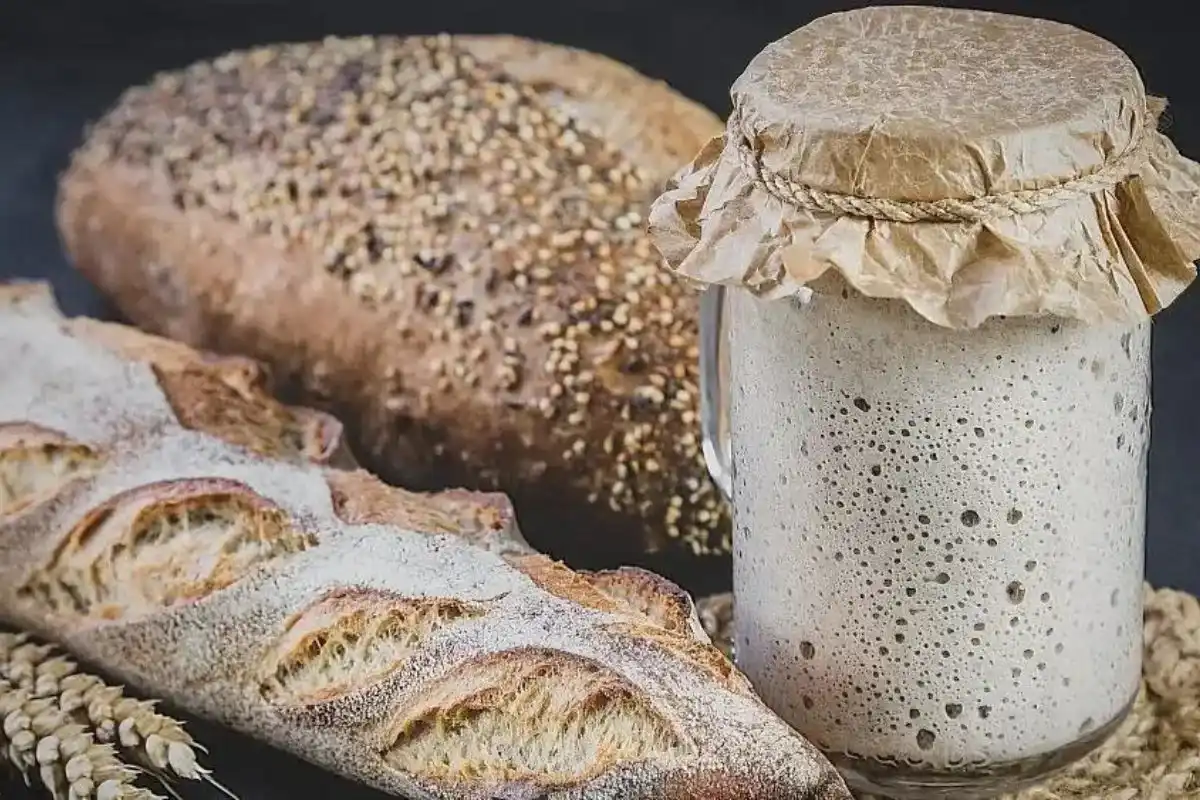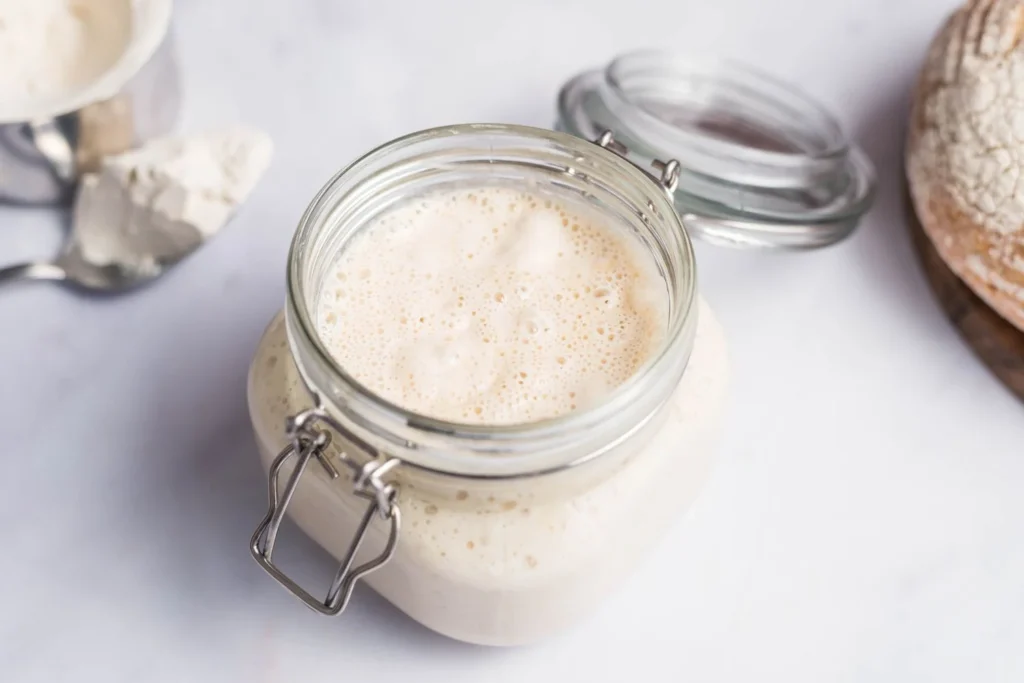
Sourdough Starter Separating? Here’s How to Fix It and Save Your Dough!
Sourdough bread has been essential in many households for centuries. The process of making sourdough involves a natural fermentation using a sourdough starter, which is a mixture of flour and water that attracts wild yeast and bacteria. This magical combination gives sourdough its distinct flavor, texture, and aroma.
However, even experienced bakers sometimes encounter issues with their sourdough starter. One common problem is when the starter begins to separate, with a layer of liquid forming on top.
This separation can be concerning, but fear not! In this article, we’ll delve into the reasons behind sourdough starter separation and provide you with practical solutions to fix it. Let’s roll up our sleeves and save that dough!
Table of Contents
ToggleWhy is My Sourdough Starter Separating?
If you’ve noticed your sourdough starter separating, you might be wondering what could be causing this phenomenon. The truth is, sourdough starter separation is a natural occurrence that can happen due to various factors. Understanding these factors is crucial in resolving the issue effectively.
Sourdough starter separation is primarily caused by the interaction between the flour and water in your starter. When the mixture ferments, carbon dioxide gas is produced, which creates bubbles and causes the starter to rise.
During this process, some of the liquid in the starter may separate from the thicker dough-like portion, resulting in a visible layer of liquid on top.

What Causes the Liquid Layer on Top of the Sourdough Starter?
The liquid layer on top of your sourdough starter, often referred to as “hooch,” is a sign of fermentation activity. Several factors contribute to its formation:
Insufficient Feeding
One common cause of sourdough starter separation is infrequent or insufficient feeding. When a starter is not fed regularly, the yeast and bacteria in the mixture exhaust the available nutrients.
As a result, the starter becomes hungry, and the fermentation process slows down. This slowdown leads to a build-up of alcohol and organic acids, which contribute to the separation of liquid.
High Hydration Level
The hydration level of your sourdough starter also plays a role in separation. A higher hydration level means a higher water-to-flour ratio. Starters with high hydration tend to separate more easily because the excess water makes it easier for the liquid to rise to the top.
Environmental Factors
Environmental conditions such as temperature and humidity can impact the behavior of your sourdough starter. Warmer temperatures accelerate fermentation, causing the starter to consume nutrients more rapidly and leading to increased separation. Similarly, high humidity can create an environment where separation is more likely to occur.
Inactive Starter
If your sourdough starter has been neglected for a long period, it may become inactive. An inactive starter lacks the vigor and vitality needed for optimal fermentation. When you revive such a starter, it may go through a phase of separation before it becomes fully active again.
How to Prevent Sourdough Starter Separation?
Prevention is always better than cure, and the same applies to sourdough starter separation. By implementing a few simple practices, you can reduce the likelihood of separation and maintain a healthy, vigorous starter.
Here are some tips to keep your sourdough starter happily bubbling:
Regular Feeding Schedule
Establishing a regular feeding schedule is crucial for maintaining a healthy sourdough starter. Feed your starter with fresh flour and water at consistent intervals. Most bakers find that feeding their starter once or twice a day works well.
Adjust the feeding frequency based on the activity level of your starter and the ambient temperature.
Proper Hydration
Maintaining an appropriate hydration level is essential for a well-balanced sourdough starter. The hydration level refers to the ratio of water to flour in your starter.
While the exact ratio may vary depending on your recipe and preferences, a 1:1 ratio (equal parts flour and water by weight) is a good starting point. Experiment with different ratios to find the consistency that suits your baking needs.
Consistent Temperature
Stability in temperature helps to create a stable environment for your sourdough starter. Yeast and bacteria thrive in consistent conditions, so aim to keep your starter in a spot where the temperature remains relatively constant.
Avoid placing it in drafty areas or near heat sources that may cause fluctuations. Consider using a proofing box or a warm spot in your kitchen to maintain an ideal temperature.
Regular Stirring
Regularly stirring your sourdough starter helps to redistribute the yeast and bacteria, promoting a more even fermentation process. Use a clean utensil to gently stir the starter, ensuring that any separated liquid gets mixed back into the mixture.
Stirring also introduces oxygen into the starter, which can benefit the yeast.
Quality Ingredients
Using high-quality ingredients is essential for a healthy sourdough starter. Opt for unbleached, organic flours and non-chlorinated water. These ingredients provide a favorable environment for the wild yeast and bacteria present in the flour.

How to Fix Separated Sourdough Starter? step-by-step
Now that we’ve covered the prevention methods, let’s dive into the steps you can take to fix a separated sourdough starter. Follow these simple guidelines, and your starter will be back in top shape in no time:
- Step 1: Discard the Liquid: Start by pouring off the separated liquid layer (hooch) from the top of your sourdough starter. Don’t worry; this liquid is not harmful, but removing it allows you to focus on rejuvenating the starter.
- Step 2: Stir the Starter: With a clean utensil, stir the remaining starter well to reintegrate any separated liquid and redistribute the yeast and bacteria throughout the mixture.
- Step 3: Feed the Starter: Discard a portion of your starter to reduce the overall volume and create space for fresh food. Depending on your recipe or feeding ratio, feed the remaining starter with a 1:1 ratio of flour and water (by weight). Mix the flour and water thoroughly into the starter until well combined.
- Step 4: Observe and Repeat: After feeding, closely monitor your starter over the next few hours. You should start to see signs of activity, such as increased bubbling and expansion. Repeat the feeding process every 12 hours or as necessary until your starter shows consistent signs of fermentation and no longer separates.
Remember, the process of fixing a separated sourdough starter may take a few days, depending on the health and activity of your starter. Be patient and persistent, and your starter will reward you with beautiful, flavorful loaves.
What if the Sourdough Starter Separation Persists?
If despite your best efforts, your sourdough starter continues to separate, it’s essential to evaluate other factors that may be contributing to the issue. Consider the following possibilities:
- Insufficient feeding: Are you feeding your starter frequently enough? It’s possible that your starter requires more frequent feedings to maintain its vigor.
- Unbalanced Hydration: Experiment with adjusting the hydration level of your starter. Some bakers find that a higher hydration level (e.g., 100% hydration) reduces separation.
- Temperature Fluctuations: Ensure that your starter is kept in a stable environment with consistent temperatures. Avoid exposing it to extreme temperature changes.
- Contamination: Check for any signs of mold or unusual odors. If your starter appears contaminated, it’s best to discard it and start fresh.
By thoroughly assessing these factors and making the necessary adjustments, you should be able to troubleshoot and resolve persistent sourdough starter separation.
Common Mistakes To Avoid When Fixing Sourdough Starter Separation
While fixing sourdough starter separation is a fairly simple process, there are a few common mistakes to avoid:
1. Don’t add too much flour or water when feeding your starter. Stick to a 1:1:1 ratio to ensure your starter stays healthy and active.
2. Don’t panic if your starter smells a little funky or looks a little weird during the fixing process – as long as it’s not moldy or discolored, it should be fine.
3. Don’t rush the process. It can take a few days of regular feedings to fully revive a separated starter, so be patient and stick with it.
Troubleshooting sourdough starter separation
If you’re still having trouble with sourdough starter separation even after following the steps above, here are a few additional tips:
- Make sure your flour and water are at room temperature before feeding your starter. Using ingredients at the same temperature helps maintain consistency in your sourdough routine, supporting a stable environment for your starter and minimizing the risk of separation.
- Consider using a different kind of flour or water – some bakers swear by using bottled spring water or switching to a different type of flour to fix separation issues. Experimenting with alternative options can introduce new microbial strains or remove potential contaminants, aiding in resolving separation problems.
- Check the temperature in your home – if it’s too hot or too cold, it can affect your starter’s activity. Extremes in temperature can hinder microbial activity, leading to inconsistent fermentation and potential separation. Adjusting your starter’s location or using insulation techniques can help maintain a favorable temperature range.
- Try adjusting the feeding schedule – some starters may do better with more or less frequent feedings. Each starter is unique, and finding the right feeding schedule is crucial. Some starters thrive with more frequent feedings to maintain a robust culture, while others may benefit from longer intervals to develop a stronger flavor profile and reduce separation tendencies. Experiment and observe your starter’s response to find the ideal feeding frequency.
Tips for Maintaining a Healthy Sourdough Starter
Once you’ve fixed your sourdough starter separation issue, it’s important to maintain a healthy and active starter. Here are a few tips to help you do just that:
- Feed your starter regularly – every 12 hours is ideal but at least once a day. Regular feeding ensures a steady supply of nutrients for your sourdough preventing separation issues and promoting a healthy fermentation process.
- Use high-quality flour and filtered water. The quality of your ingredients directly impacts the vitality of your starter. Opt for unbleached flours and chlorine-free water to avoid potential contaminants that could disrupt the balance of your sourdough ecosystem.
- Store your starter in a warm, consistent environment – around 70-75 degrees Fahrenheit is ideal. Temperature plays a crucial role in the activity of your starter. By providing a stable and slightly warm environment, you encourage optimal yeast and bacteria growth, minimizing the chances of separation.
- Consider keeping your starter in a clear container so you can easily monitor its activity. Transparency helps you assess the progress and health of your starter. Being able to observe bubbles, rise, and any unusual changes allows you to catch separation early and take necessary corrective measures.
- If you won’t be able to feed your starter for a few days, store it in the fridge to slow down fermentation. Life happens, and sometimes we can’t maintain our sourdough routine. To prevent your starter from starving or separating, place it in the refrigerator. The colder temperature will slow down fermentation, allowing you more flexibility without compromising the integrity of your starter.

My Sourdough Starter Has Hooch But Isn’t Rising
So, you’ve diligently followed all the steps to address sourdough starter separation, but you’re facing a new challenge: your starter has hooch (the liquid layer on top) yet it isn’t showing signs of rising as expected.
Don’t worry; we’re here to troubleshoot this issue and guide you on how to revive your sourdough starter.
Hooch is typically a sign of fermentation activity, so the fact that you have hooch is a positive sign. However, if your starter isn’t rising along with it, it might indicate an underlying problem that needs attention. Here are some possible reasons and solutions:
- Insufficient Feeding: If your starter is producing hooch but not rising, it might be hungry. Make sure you’re feeding it regularly and adjusting the feeding schedule based on its activity level and ambient temperature. A hungry starter won’t have the energy to rise properly.
- Low Activity: Your starter may not be as active as it should be. This could be due to factors like temperature or the quality of your flour. Ensure that your starter is kept in a warm, stable environment, and consider using high-quality flour.
- Imbalanced Hydration: The hydration level of your starter can affect its ability to rise. If it’s too dry, it might not rise properly. Experiment with adjusting the hydration level by adding more water during feedings.
- Starter Health: Sometimes, starters can go through phases of being less active. Continue with your regular feeding routine, and give it time. Patience is key when reviving a starter that has temporarily lost its vigor.
- Environmental Factors: Changes in temperature and humidity can impact your starter’s behavior. Make sure you’re maintaining a consistent environment for your starter to thrive.
- Inactivity Period: If your starter has been stored in the refrigerator or neglected for a while, it might take some time to regain its activity. Continue with regular feedings and monitor its progress.
Here’s what you can do to address the issue:
Step 1: Pour off the hooch as usual to remove the separated liquid layer.
Step 2: Stir the remaining starter well to reintegrate any separated liquid and redistribute the yeast and bacteria.
Step 3: Feed the starter with a 1:1 ratio of flour and water (by weight) or adjust the hydration level if needed.
Step 4: Keep a close eye on your starter over the next few hours and days. You should start to see signs of activity, such as increased bubbling and expansion.
Remember, the process of reviving a sourdough starter can take some time, and it may not rise immediately after you start feeding it again. Be patient, maintain a consistent feeding schedule, and provide the right environment for your starter to thrive.
FAQS | About Sourdough Starter Separation
Is sourdough starter separation normal?
Yes, sourdough starter separation is relatively common and occurs due to the natural fermentation process. It doesn’t necessarily indicate a problem with your starter and can be easily resolved.
Can I still use a separated sourdough starter?
Yes, you can still use a separated sourdough starter. Simply pour off the separated liquid (hooch) and proceed with your regular feeding routine. The starter will regain its vitality with time.
How often should I feed my sourdough starter?
The frequency of feeding your sourdough starter depends on various factors such as ambient temperature, hydration level, and activity of the starter. As a general guideline, feeding your starter once or twice a day is a good starting point. Adjust the feeding frequency based on the health and activity of your starter.
Can temperature affect sourdough starter separation?
Yes, temperature can affect sourdough starter separation. Warmer temperatures accelerate fermentation, which can lead to increased separation. It’s important to maintain a stable temperature to ensure consistent starter behavior.
Should I discard the liquid on top of my sourdough starter?
Yes, it’s recommended to discard the liquid (hooch) on top of your sourdough starter. While not harmful, hooch can indicate that your starter needs feeding. Removing it allows you to focus on rejuvenating the starter.
Conclusion
Don’t let a separated sourdough starter discourage you from baking delicious loaves of bread. By understanding the reasons behind this issue and implementing the solutions we’ve discussed, you can rescue your starter and keep it thriving. Remember to maintain a regular feeding schedule, provide a stable environment, and adjust hydration levels as needed.
Now that you’re armed with knowledge on how to fix a separated sourdough starter, it’s time to put these techniques into practice. Embrace the joy of baking with sourdough, and may your loaves rise to perfection every time!
Lindsey Mackenzie
About me
Hi there! I’m Lindsey Mackenzie, the founder of Bake Smartly. Baking has been my passion since childhood, growing up in my father’s bakery. With Bake Smartly, I’m excited to share my love for all things sweet and savory. Join me on this delicious journey as we whip up scrumptious treats and sprinkle joy into every bite!






